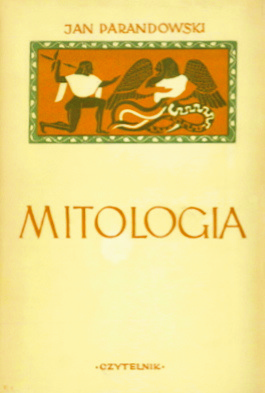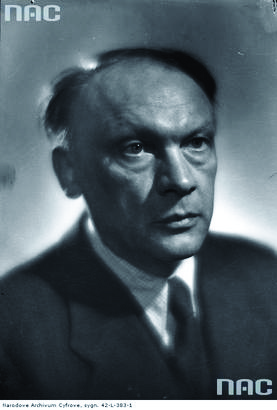Title of the work
Country of the First Edition
Country/countries of popularity
Original Language
First Edition Date
First Edition Details
Jan Parandowski, Mitologja. Wierzenia i podania Greków i Rzymian. Lwów: Księgarnia wydawnicza H. Altenberga we Lwowie, 1924, 252 pp.
ISBN
Available Onllne
biblioteka.kijowski.pl(accessed: December 30, 2020)
Genre
Myths
Target Audience
Crossover (Children, teenagers, young adults, teachers)
Cover

Cover from the edition Warsaw: Czytelnik, 1950. Cover design by Jan S. Miklaszewski.
Author of the Entry:
Summary: Agata Więcławska, University of Warsaw, a.wieclawska@student.uw.edu.pl
Analysis: Marta Pszczolińska, University of Warsaw, m.pszczolinska@al.uw.edu.pl
Peer-reviewer of the Entry:
Katarzyna Marciniak, University of Warsaw, kamar@al.uw.edu.pl
Elżbieta Olechowska, University of Warsaw, elzbieta.olechowska@gmail.com

Photograph by Edward Hartwig, retrieved from the National Digital Archives.
Jan Parandowski
, 1895 - 1978
(Author)
Classical philologist and archaeologist. An outstanding and prolific author of books related to Antiquity; translator of classical masterpieces. Contributed to many Polish newspapers and magazines. Chairman of the Polish PEN Club from 1933 to 1978. Recipient of prizes for outstanding literary achievements, such as a bronze medal received at the 1936 Berlin Summer Olympics for his book Dysk olimpijski [Olympic Discus]. Member of the European Society of Culture. In 1962 he was elected Vice-President of the International PEN. An exceptionally successful supporter and advocate of Classical Antiquity in Poland. His Mitologia. Wierzenia i podania Greków i Rzymian [Mythology. Beliefs and Legends of the Greeks and Romans], still often read even in primary school, remains for many generations of Polish readers a fundamental source of the knowledge of ancient myths.
Major works: Eros na Olimpie [Eros on the Olympus], 1924, Mitologia. Wierzenia i podania Greków i Rzymian [Mythology. Beliefs and Legends of the Greeks and Romans], 1924; Wojna trojańska [Trojan War], 1927; Oscar Wilde’s biography Król życia [A King of Life], 1930; Dysk olimpijski [Olympic Discus], 1933; Niebo w płomieniach [Heaven in Flames], 1936; Trzy znaki zodiaku [Three Signs of the Zodiac], 1938; Godzina śródziemnomorska [The Mediterranean Hour], 1949; a study on creative writing Alchemia słowa [Alchemy of the Word], 1951. He also translated into Polish Caesar’s Civil War, 1951, and Homer’s Odyssey, 1953.
Sources:
Krełowska, Danuta, Jan Parandowski: życie i twórczość, Toruń: Wojewódzka Biblioteka Publiczna i Książnica Miejska im. M. Kopernika, 1989.
Paciorkowska, Monika, Jan Parandowski, slideshare.net (accessed: December 30, 2020).
"Parandowski Jan", in Jadwiga Czachowska and Alicja Szałagan, eds., Współcześni polscy pisarze i badacze literatury. Słownik biobibliograficzny, vol. 6: N–P, Warszawa: Wydawnictwa Szkolne i Pedagogiczne, 1999, 254–260.
"Parandowski, Jan", in Encyklopedia PWN, encyklopedia.pwn.pl (accessed: December 30, 2020).
wikipedia.org (accessed: December 30, 2020).
Życiorys Jana Parandowskiego, kul.pl (accessed: December 30, 2020).
Bio prepared by Joanna Grzeszczuk, University of Warsaw, joannagrzeszczuk1@gmail.com
Translation
Hebrew: מיתולוגיה : אגדות יוון ורומא [Mitologyah : agadot Yaṿan ṿe-Roma / Miytŵlŵgyah : ʾagadŵt Yawwan w-Rŵma], trans. Daṿid Lazer, Tel-Aviv: Ktavim, [5]712 1952; Tel-Aviv: A. Zelkovits, 1958.
Latvian: Mitoloģiâ : grieķu un romiešu ticējumi un teiksmas, trans. Jazeps Osmanis, Riga: Žinatne, 1976.
Russian: Мифология. Верования и легенды греков и римлян [Mifologiâ. Verovaniâ i legendy Grekov i Rimlân], trans. Nikolaj Ivanovič Dubov, Moskva: Izdatel'stvo Detskaâ Literatura, 1971.
Slovak: Mytológia, (Čitanie Študujúcej Mládeže 123), trans. Jozef Marušiak, Bratislava: Tatran, 1980.
Ukrainian: Міфологія. Вірування та легенди стародавніх греків та римлян [Mìfologìâ: vìruvannâ ta legendi starodavnìh Grekìv ì Rimlân], trans. Olʹga Lênìk, Kiïv: Vidavnictvo CK LKSMU "Molodʹ", 1977.
Summary
Based on: Katarzyna Marciniak, Elżbieta Olechowska, Joanna Kłos, Michał Kucharski (eds.), Polish Literature for Children & Young Adults Inspired by Classical Antiquity: A Catalogue, Faculty of “Artes Liberales”, Warsaw: University of Warsaw, 2013, 444 pp.
Description of the most important Greek and Roman myths. This is a significant, or even the most important book responsible for increasing basic awareness of ancient culture in Poland for a number of reasons. First, the author opts for milder versions of events – without brutality, drastic fight scenes, rapes, moral controversies. This allows to use the book in elementary school. Second, Mythology is written in a simple, but extremely elegant and colourful language. Author uses many literary epithets, elements of dialogue, repeatedly quotes Polish poets such as: Jan Kochanowski, Sebastian Fabian Klonowic, Franciszek Dionizy Kniaźnin, Adam Mickiewicz (see p. 197)*, Juliusz Słowacki, Adam Asnyk, or Bolesław Leśmian, demonstrating the connections between Polish literature and ancient Graeco-Roman tradition.
* Summary based on edition Warsaw: Czytelnik, 1950, 351 pp.
Analysis
Jan Parandowski published Mythology with school teachers in mind. The language is adjusted to the young reader, and the versions of myths are softened, deprived of more cruel details or some immoral matters. The author enriches the text with quotes from ancient and modern authors to show how ancient culture fluctuated and inspired later centuries. Even though the book is almost a hundred years old, it is still appreciated and continues to be used in school as an optional selection. Thus, for many children, it could be the first contact with Greek and Roman myths.
The type of ad usum Delphini censorship practiced by Parandowski is easily noticeable even in the first chapter about creation, where Ouranos gets “shamefully mutilated” and then Aphrodite is said to appear out of foam near Cyprus. This removes a significant element connected with sexuality from Hesiod’s version. Similarly, according to Theocritus, Hylas is Heracles’ lover, in Parandowski’s retelling, their relation is of a different nature, he is Heracles’ beautiful son; the motif of kidnapping by nymphs to share their love is omitted. Another example of a milder version of a myth is the story of seduction and love affair of Zeus and Leda, which is omitted. Instead, Leda and her husband Tyndareus live in sadness because of being childless and then get an egg from Hermes. Children hatched from the egg did not have parents, and that was why they were told to have descended from Zeus. In the myth about Tereus and Procne, the author omits the motif of the rape of Philomela (preserving, however, the act of cutting her tongue out). Also, the matter of Pasiphae’s lust as a punishment for Minos’ greed and hubris is removed. Minos is described as a wise ruler who can extend his power without conquest through reasonable coexisting with other lands (no mention here of Athens and the human tribute). There was, however, no happiness in his home as his wife bore a hybrid child, half human, half bull.
The matter of women’s jealousy is often presented as unjustified. Hera, who spies on Zeus and the beautiful Io, sees them walking together, talking, and laughing. Deianira’s jealousy is described as unreasonable as well. There is no mention of her husband’s attraction to Iole, which could have resulted in him abandoning his wife. Parandowski clearly states that Deianira was obsessively jealous as it seemed to her that every woman is a dangerous rival for her, and that she was wrong of course, as Heracles loved her with all his heart. This approach is connected to the assessment of the character as a role model. Heracles is shown to be loved more than gods by people who remember he used to be a man. He was a humble (before Eurystheus), just (he cleaned roads from rogues and bandits), and good man who remained unspoiled as what he did was always done out of necessity. He is a role model hero as he puts an end to wickedness and cruelty; killing his teacher in a furious rage, is omitted. When the author does not remove sensitive content, he makes an appropriate comment. For example, he writes about Theseus as a great hero, but then he mentions that he abducted a seven-year-old Helen from Sparta to raise her to be his wife when he was fifty. The author calls it a huge mistake, and when he sums up the character of Theseus, he glorifies him and does not include the stories of Helen’s kidnapping or Antiope’s abduction. Also, the case of Euridice’s death, caused by Apollo’s son, Aristaeus, chasing her, is only shown to happen because of a misunderstanding – Aristaeus did not know that Euridice was Orpheus’ wife. The author explains that had he known who she was, he would obviously have stayed at home trying to forget about the beautiful nymph.
Parandowski removed these details present in mythology, not so much to reveal his views on morality, but rather to adjust the content, making it suitable for primary school. All the tales that were chosen to be glossed over or removed, later, appeared as an independent book entitled Eros on Olympus aimed at adults, as the title suggests.
The author presents the myths and describes many customs (holidays, celebrations, sacrifices, rites) and historical facts strongly connected with the beliefs. For example, he mentions the bringing of the remains of Theseus to Athens by Kimon in 474 B.C., or the Athenian sacrifices to Boreas and his Athenian wife Orithyia suggested by the oracle of Delphi during Xerxes’ invasion of Greece. The sacrifices were made, and Boreas responded by causing a powerful wind which damaged the Persian fleet. The quotes from ancient sources embellish the narration and show how the mythical stories are integrated with ancient culture. He cites Lucretius about Aphrodite, Agathon about Eros, Euripides about Dionysus, Plinius about Fortuna, and Porphyry’s hymn to souls at the threshold of the Underworld.
The illustrations accompany the text: In the first editions, according to the style of presentation used at that time, there are many drawings of ancient artifacts, sculptures, reliefs or pottery paintings, like Ares Ludovisi, showing how the characters were imagined in Antiquity.
Further Reading
Baran-Radwańska, Marzena, Tradycje pisarstwa. O eseistyce Jana Parandowskiego, Sanok: Drukarnia „Piast Kołodziej”, 2011.
Kossewska, Elżbieta, “Hebrajski przekład Mitologii. Listy Jana Parandowskiego, Dawida Lazera i Dawida Ben Guriona”, Pamiętnik Literacki 2 (2018), 183–207.
Krełowska, Danuta, Jan Parandowski: życie i twórczość, Toruń: Wojewódzka Biblioteka Publiczna i Książnica Miejska im. M. Kopernika, 1989.
Lichański, Jakub Zdzisław, Wtajemniczenia i refleksje. Szkic monograficzny o Janie Parandowskim, Łódź: Wydawnictwo Łódzkie, 1986.
Maresz, Barbara, “Mitologia Jana Parandowskiego w ilustracjach Jana Marcina Szancera”, Guliwer: dwumiesięcznik o książce dla dziecka 4 (2003), 27–28.
Selected bibliography concerning Jan Parandowski’s work and life see here.


